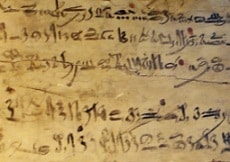In order to discover the meaning of the hieratic term, it is necessary, first of all, to take the step of knowing its etymological origin. In this case, we can establish that it is a word that derives from Latin, exactly from “hieraticus” which emanates, in turn, from “hierateia” which can be translated as “priesthood.” However, these Latin terms in turn come from Greek, specifically, from “ieratikós”, which is synonymous with “priestly”.
The Royal Spanish Academy ( RAE ) recognizes several meanings of this concept.
 The first meaning mentioned by the RAE refers to the gesture or style of great solemnity . The hieratic, in this framework, is linked to the pompous or the affected . For example: “With a hieratic gesture, the old man rejected the invitation and continued walking,” “The artist remained hieratic throughout the concert and hardly interacted with the audience,” “The monarch listened hieratic to the president's speech and then turned away.” “He came to greet him.”
The first meaning mentioned by the RAE refers to the gesture or style of great solemnity . The hieratic, in this framework, is linked to the pompous or the affected . For example: “With a hieratic gesture, the old man rejected the invitation and continued walking,” “The artist remained hieratic throughout the concert and hardly interacted with the audience,” “The monarch listened hieratic to the president's speech and then turned away.” “He came to greet him.”
Hieratic is also that related to priests and sacred elements of Antiquity . In this context, the idea makes mention of the spirituality of pagan peoples.
For all the above, we have to state that among the synonyms of hieratic we find words such as hermetic, religious, inexpressive, sacred, unalterable, priestly, solemn or sacerdotal, for example.
Hieratic writing , meanwhile, was used by the ancient Egyptians, constituting an abbreviation of hieroglyphic writing . An etymological “explanation” of this use of the term can be found in the stone engravings made by the priests of that time.
When one wanted to write quickly and more simply than in hieroglyphs , hieratic writing was used. In this way, religious texts could be created, but also administrative ones.
This type of writing was also useful for writing on papyrus with the calamus, a hollow reed. It is considered that the hieratic began to be used in the so-called Protodynastic Period of Egypt , which developed between 3300 and 3100 BC .
Although there are hieratic signs that are similar to hieroglyphics, experts believe that hieratic does not derive from hieroglyphic writing. Both systems developed simultaneously, evolving in parallel.
Other data of interest about the aforementioned hieratic writing are the following:
-It was always written from right to left.
-It was written on materials such as linen, leather, tablets, papyrus or even wood.
-As a general rule, it was written horizontally. However, on other occasions, it was resorted to developing it in columns.
-Although sometimes this type of writing and hieroglyphics tend to be confused, the truth is that the main difference that exists between the two is the existence of what is known as a ligature. This was the union of symbols that was used to fundamentally shape groups of symbols. Likewise, it should be noted that the hieratic turns out to be much more fluid and stylized in its forms.
-It is established that it was used regularly until the year 700 BC, when it was replaced by the so-called demotic writing.
